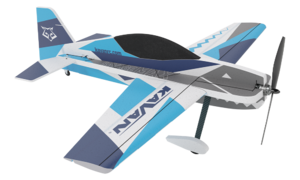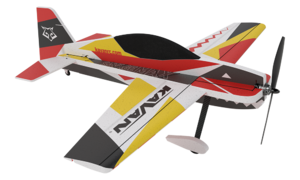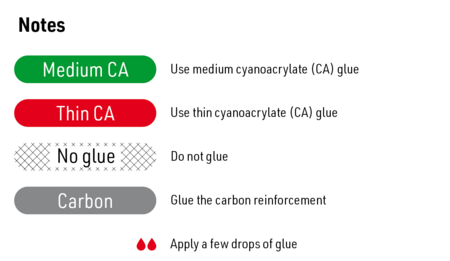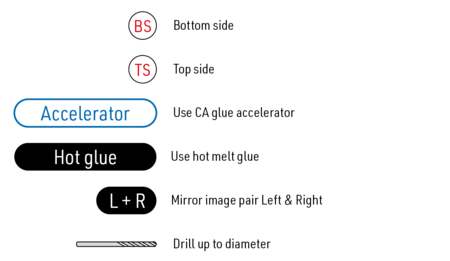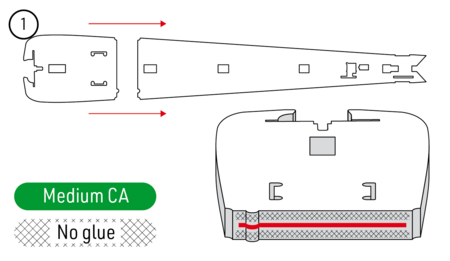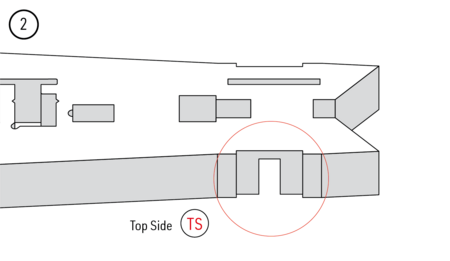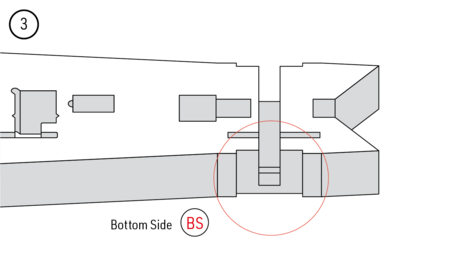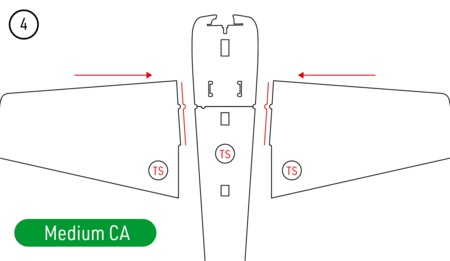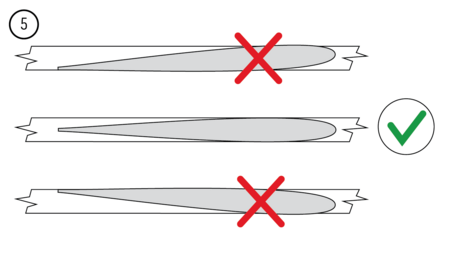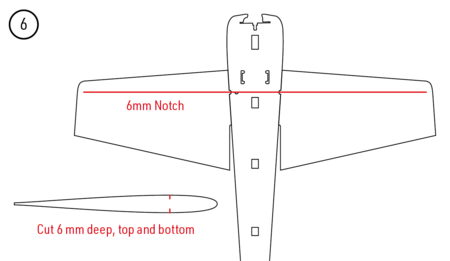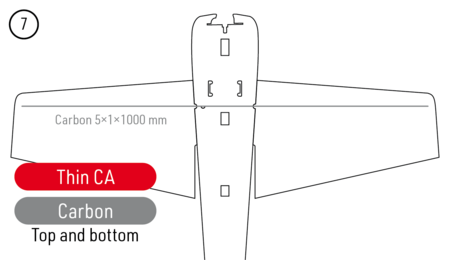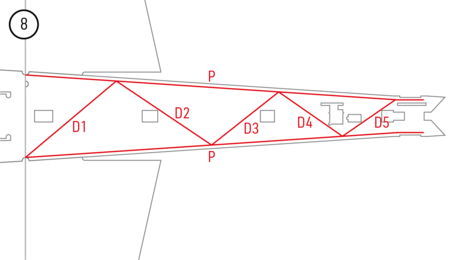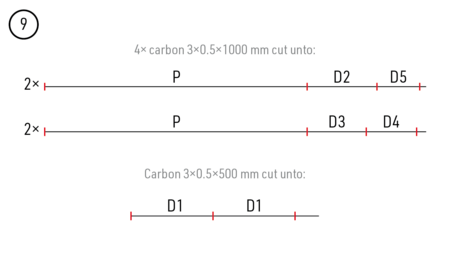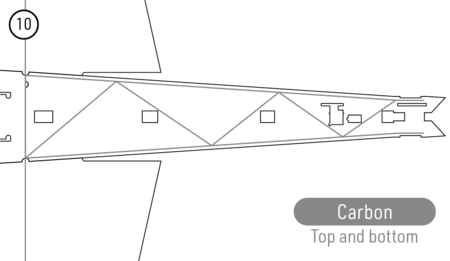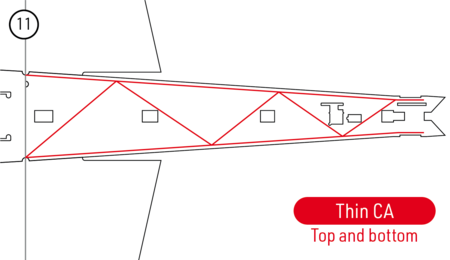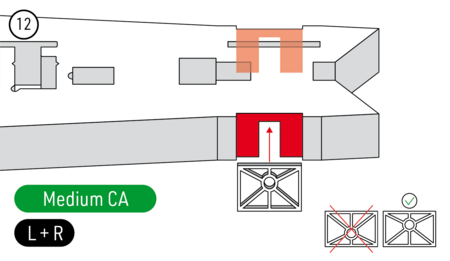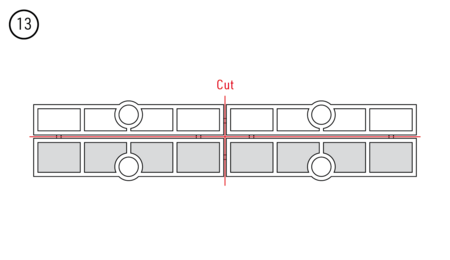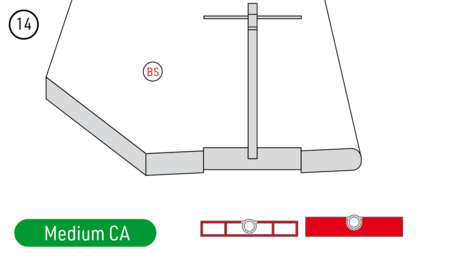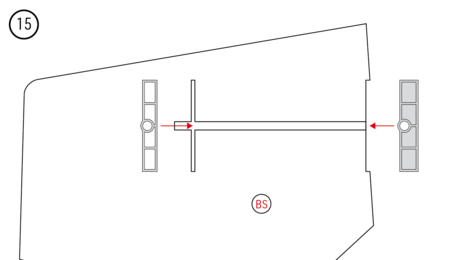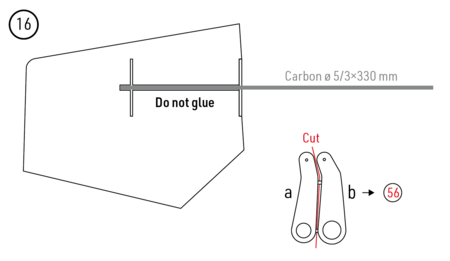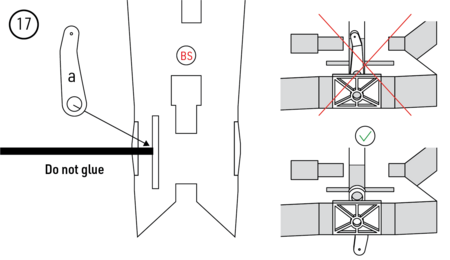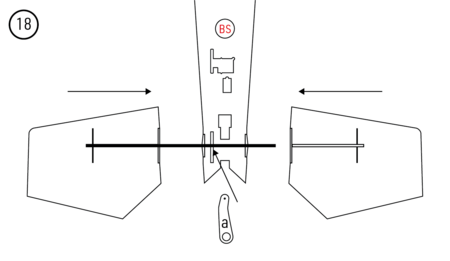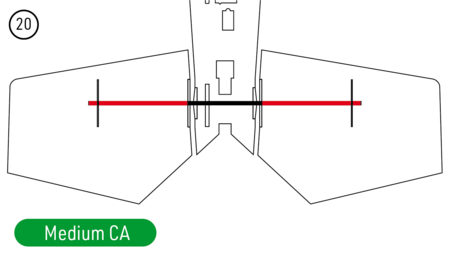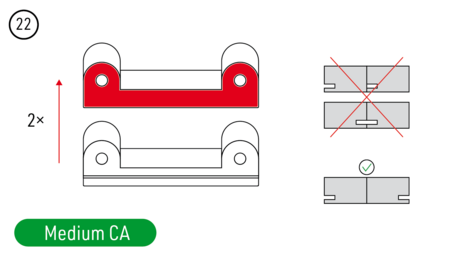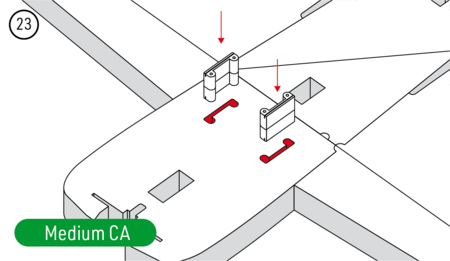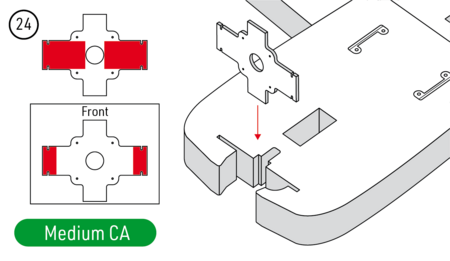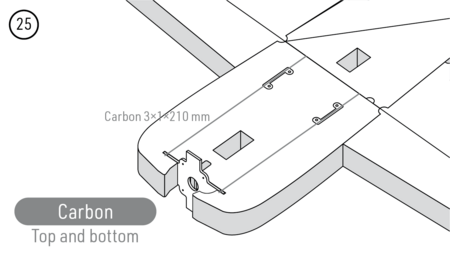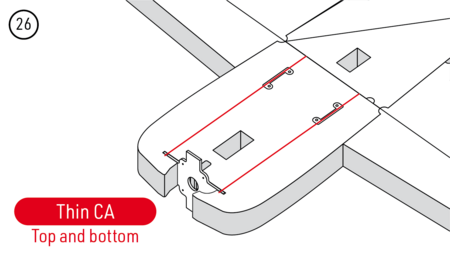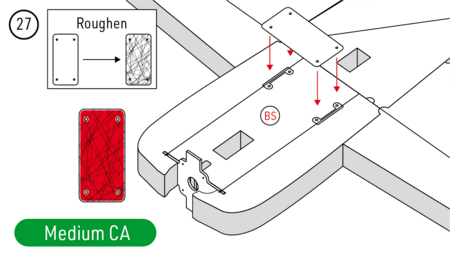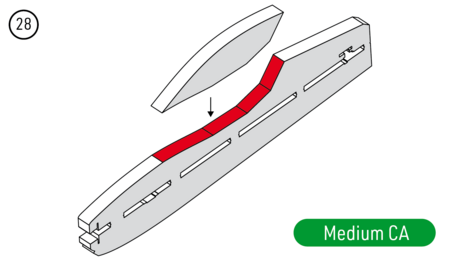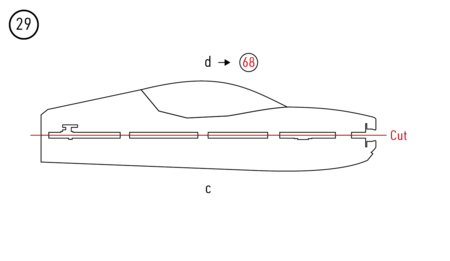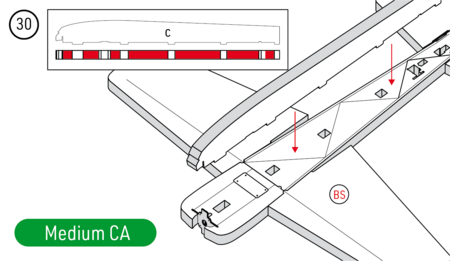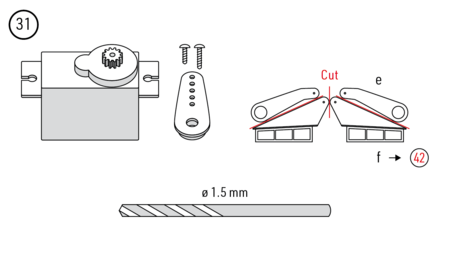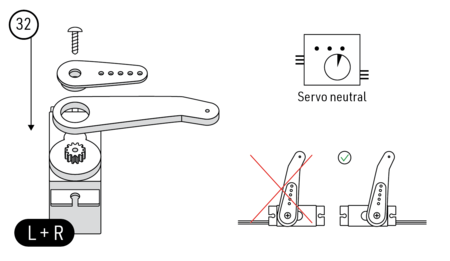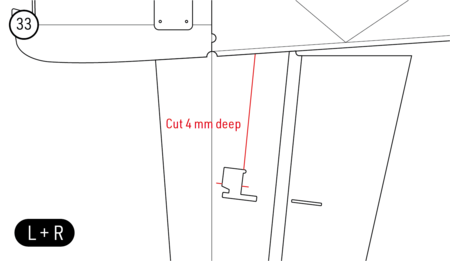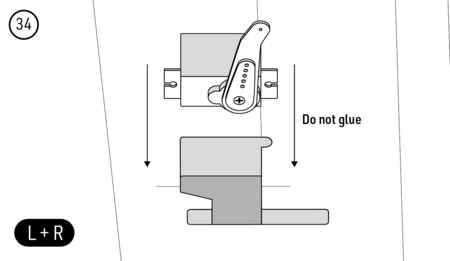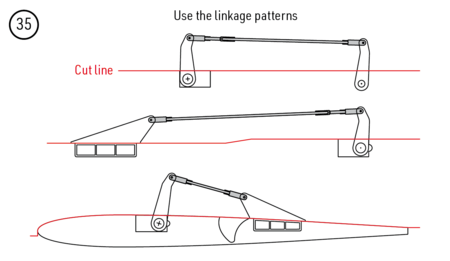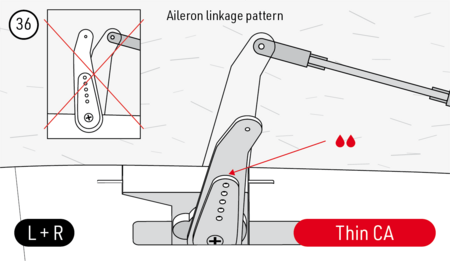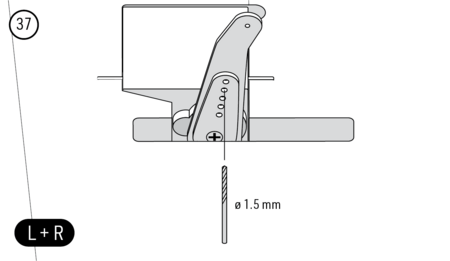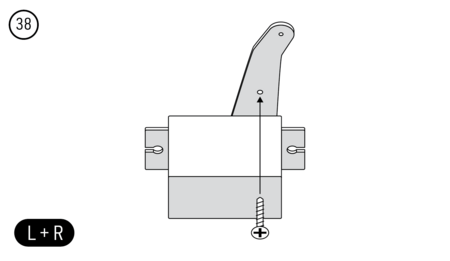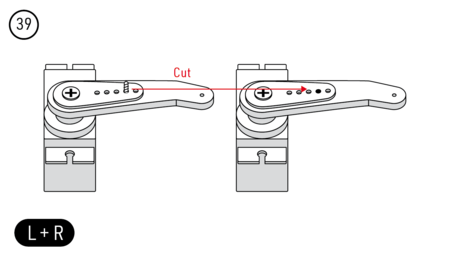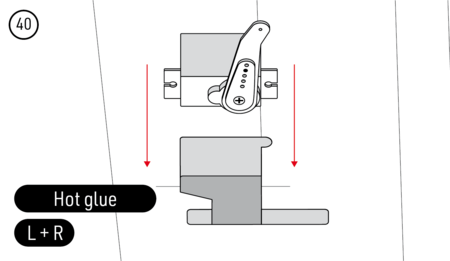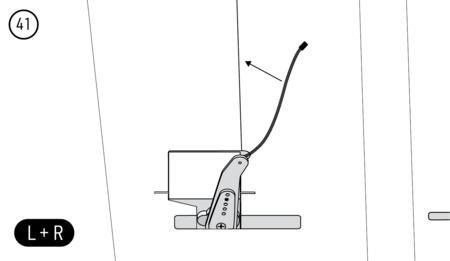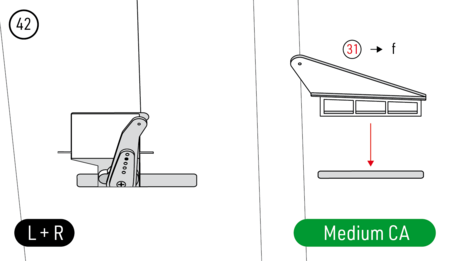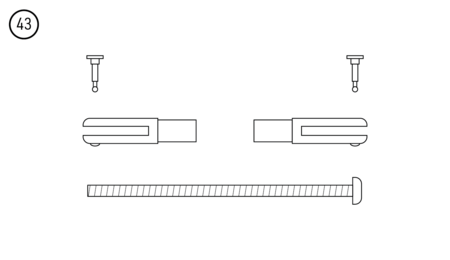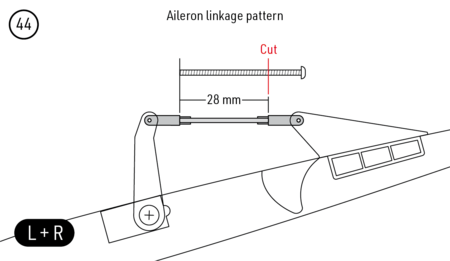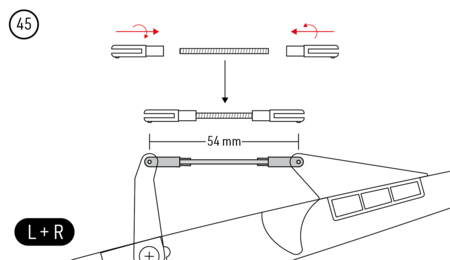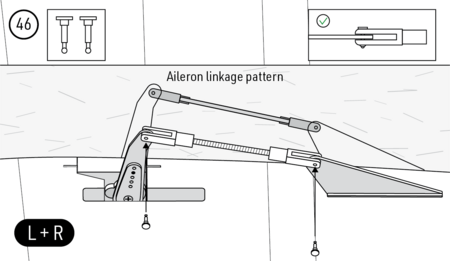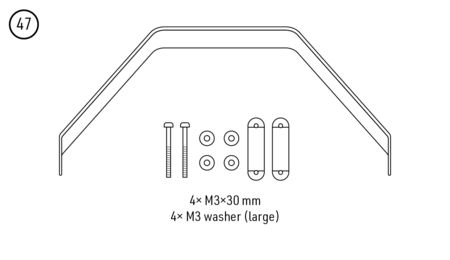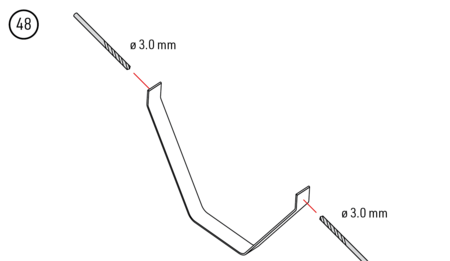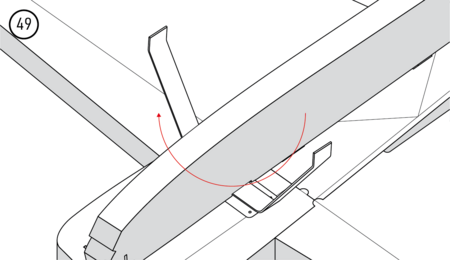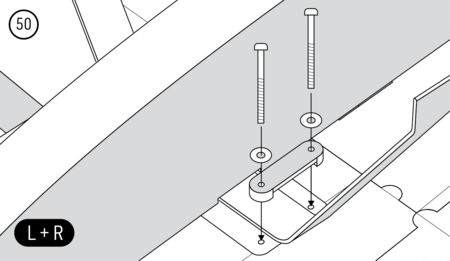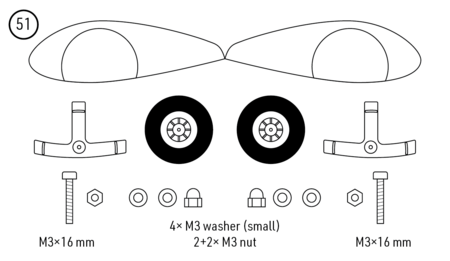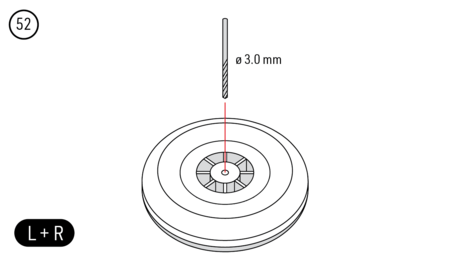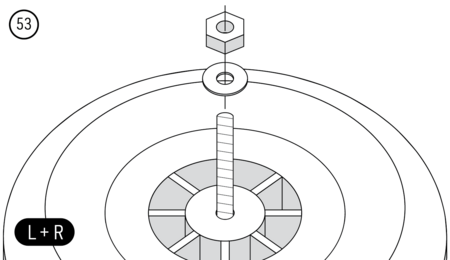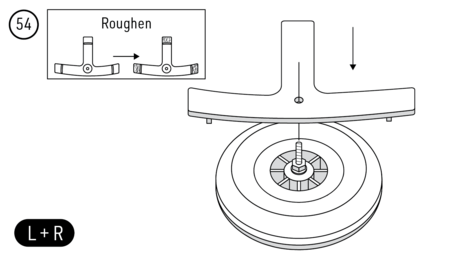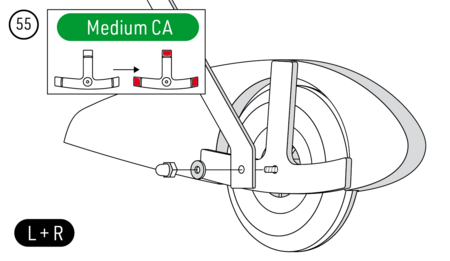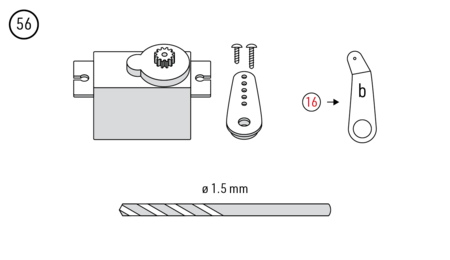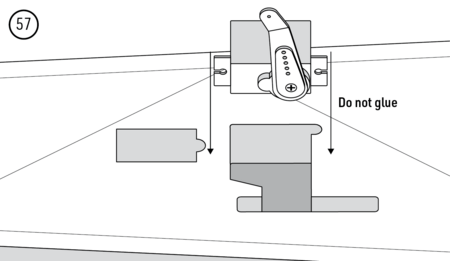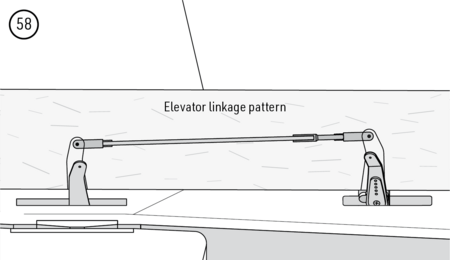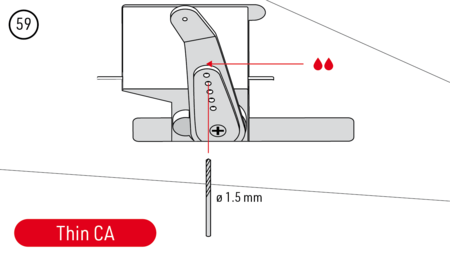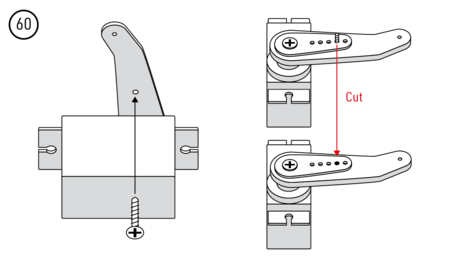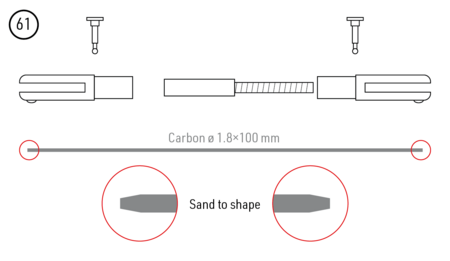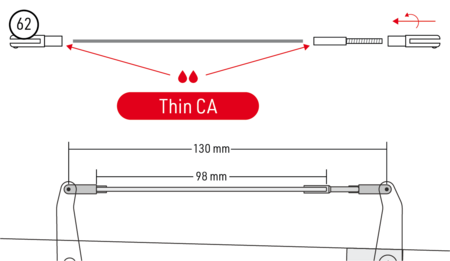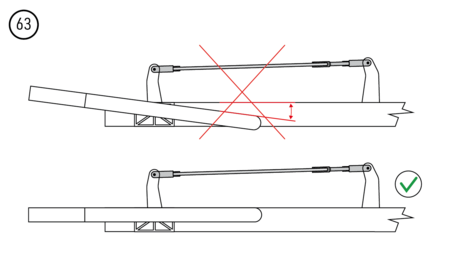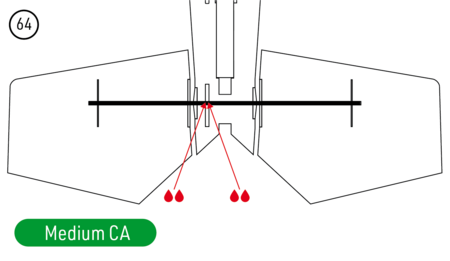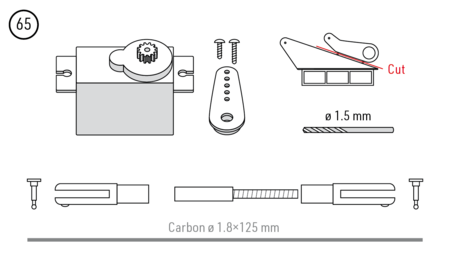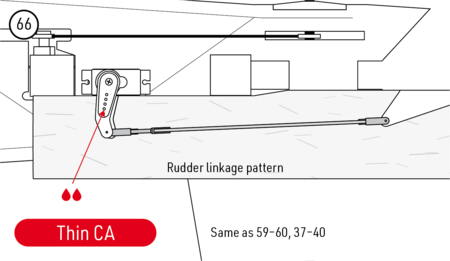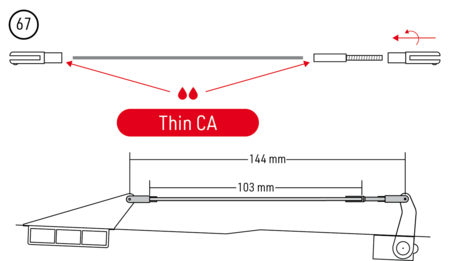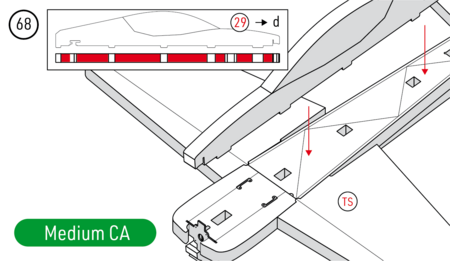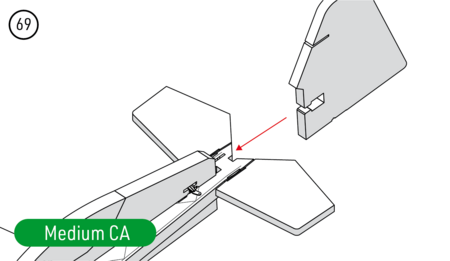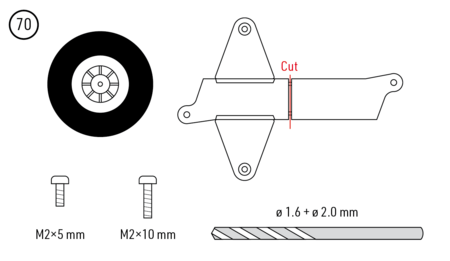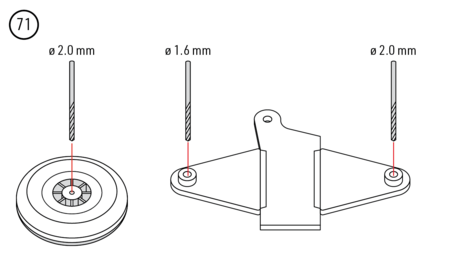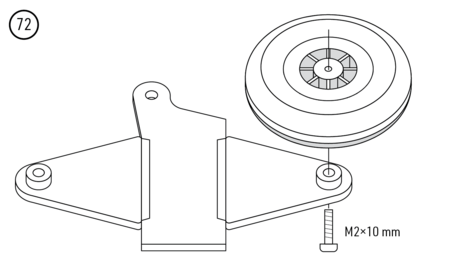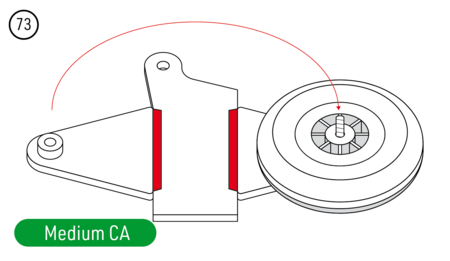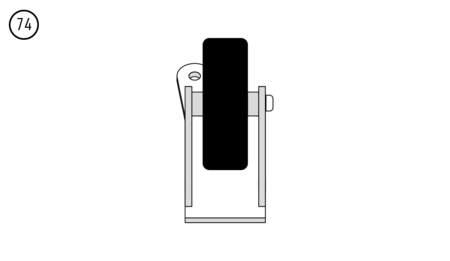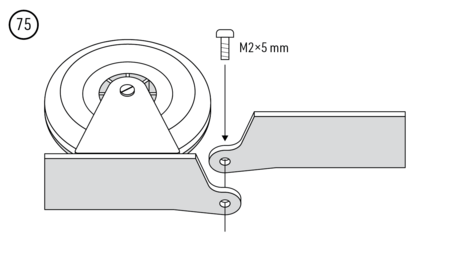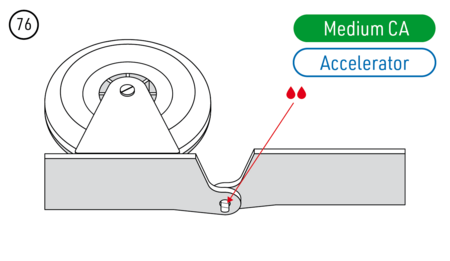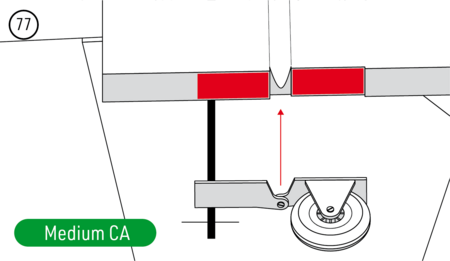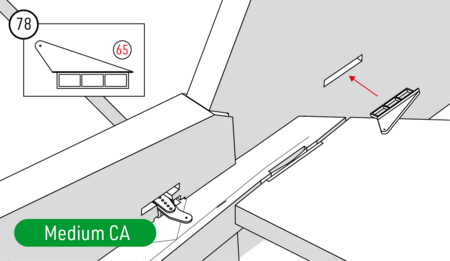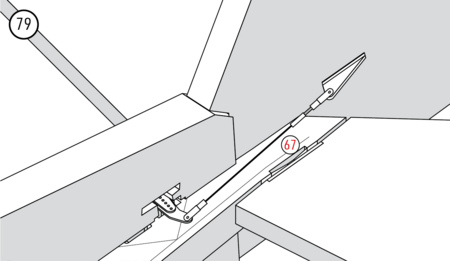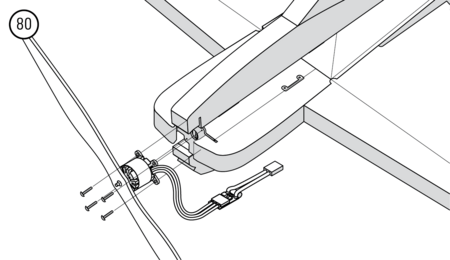KAVAN Savage MAX - Instruction manual: Difference between revisions
Mrs. Kavan (talk | contribs) (Created page with "== Introduction == Congratulation on your purchase of the high performance 3D aerobatic SAVAGE MAX model! You are about to start the assembly of a model manufactured from virtually unbreakable EPP (extruded polypropylene) foam powered by a mighty brushless motor and lightweight LiPo battery. Everybody who has already mastered flying a “full house” trainer - with aileron, elevator, rudder, and throttle control - will enjoy this beast! === Before you start === # If y...") |
m (Protected "KAVAN Savage MAX - Instruction manual" ([Edit=Allow only administrators] (indefinite) [Move=Allow only administrators] (indefinite)) [cascading]) |
||
| (30 intermediate revisions by 2 users not shown) | |||
| Line 1: | Line 1: | ||
<languages/> | |||
<translate> | |||
<!--T:1--> | |||
== Introduction == | == Introduction == | ||
Congratulations on your purchase of the high-performance 3D aerobatic SAVAGE MAX model. You are about to start the assembly of a model manufactured from virtually unbreakable EPP (extruded polypropylene) foam powered by a mighty brushless motor and lightweight LiPo battery. Everybody who has already mastered flying a "full house" trainer - with aileron, elevator, rudder, and throttle control - will enjoy this beast. | |||
=== | <!--T:28--> | ||
{{Image frame|width=900|content=[[File:KAVAN Savage MAX - blue.png|300px|KAV02.8025 KAVAN Savage MAX - blue]][[File:KAVAN Savage MAX - red.png|300px|KAV02.8026 KAVAN Savage MAX - red]]|align=center|pos=bot|caption=<br>[https://kavanrc.com/item/kavan-savage-max-blue-145602 '''KAV02.8025'''] '''KAVAN Savage MAX - {{font color | #0072B6 | blue }}'''   {{!}}   [https://kavanrc.com/item/kavan-savage-max-red-145603 '''KAV02.8026'''] '''KAVAN Savage MAX - {{font color | #E30613 | red}}'''}} | |||
=== Before you start === <!--T:2--> | |||
<!--T:3--> | |||
# If you are not an experienced RC pilot, plan to have a fully competent pilot check your completed model and help you with your first flights. Even though we have tried to provide you with a thorough instruction manual, RC models are rather complicated and an experienced modeller can quickly check over your model to make sure your first flights are successful. | # If you are not an experienced RC pilot, plan to have a fully competent pilot check your completed model and help you with your first flights. Even though we have tried to provide you with a thorough instruction manual, RC models are rather complicated and an experienced modeller can quickly check over your model to make sure your first flights are successful. | ||
# Please assemble your model exactly according to these instructions. Do not attempt to modify or change your model in any way, as doing so may adversely change its flying characteristics. | # Please assemble your model exactly according to these instructions. Do not attempt to modify or change your model in any way, as doing so may adversely change its flying characteristics. | ||
# Before you begin, please check the entire contents of this kit to make sure that no parts are missing or damaged. This will also help you to become familiar with each component of your plane. If you find that any of the parts are either missing or damaged, please contact your dealer immediately for replacement. Note: Your dealer cannot accept kits for return if construction has begun. | # Before you begin, please check the entire contents of this kit to make sure that no parts are missing or damaged. This will also help you to become familiar with each component of your plane. If you find that any of the parts are either missing or damaged, please contact your dealer immediately for replacement.<br>{{Note|type=info|'''Note:''' Your dealer cannot accept kits for return if construction has begun.}} | ||
# Trial fit each part before | # Trial fit each part before glueing it in place. Make sure you are using the correct part and that it fits well before assembling. No amount of glue can make up for a poorly fitting part. | ||
# The manual contains a drawing showing the default position of the Centre of Gravity (CG) and recommended control surface throws. Please note it is essential to keep the recommended CG position for the first flight otherwise the model could be unstable, hard to control or even unable to fly at all! Later, you can fine tune the CG position to suit your flying style and skills. | # The manual contains a drawing showing the default position of the Centre of Gravity (CG) and recommended control surface throws. Please note it is essential to keep the recommended CG position for the first flight otherwise the model could be unstable, hard to control or even unable to fly at all! Later, you can fine-tune the CG position to suit your flying style and skills. | ||
<!--T:4--> | |||
=== Precautions === | |||
'''This RC model is not a toy.''' '''Use it with care and strictly following the instructions in this manual.''' | |||
<!--T:5--> | |||
Assemble this model following strictly these instructions. DO NOT modify or alter the model. Failure to do so, the warranty will lapse automatically. Follow the instructions to obtain a safe and solid model at the end of the assembly. | |||
<!--T:6--> | |||
Children under the age of 14 must operate the model under the supervision of an adult. | |||
<!--T:7--> | |||
Assure that the model is in perfect condition before every flight, taking care that all the equipment works correctly and that the model is undamaged in its structure. | |||
<!--T:8--> | |||
Fly only on days with a light breeze and in a safe place away from any obstacles. | |||
=== Safety precautions and warnings === | === Safety precautions and warnings === <!--T:9--> | ||
* An RC aeroplane is not a toy! If misused, it can cause serious bodily harm and damage to property. Fly only | <!--T:10--> | ||
* As the user of this product, you are solely responsible for operating it in a manner that does not endanger yourself and others or result in damage to the product or the property of others. This model is controlled by a radio signal that is subject to interference from many sources outside your control. This interference can cause momentary loss of control so it is advisable to always keep a safe distance in all directions around your model, as this margin will help to avoid collisions or injury. | * An RC aeroplane is not a toy! If misused, it can cause serious bodily harm and damage to property. Fly only in a safe place, following all instructions and recommendations in this manual. Beware of the propeller! Keep loose items that can get entangled in the propeller away from the spinning propeller, including loose clothing, or other objects such as pencils and screwdrivers. Ensure that your and other people’s hands and face are kept away from the rotating propeller. | ||
* As the user of this product, you are solely responsible for operating it in a manner that does not endanger yourself and others or result in damage to the product or the property of others. This model is controlled by a radio signal that is subject to interference from many sources outside your control. This interference can cause momentary loss of control, so it is advisable to always keep a safe distance in all directions around your model, as this margin will help to avoid collisions or injury. | |||
* Never operate your model with low transmitter batteries. | * Never operate your model with low transmitter batteries. | ||
* Always operate your model in an open area away from power lines, cars, traffic, or people. Avoid operating your model in populated areas where injury or damage can occur. | * Always operate your model in an open area away from power lines, cars, traffic, or people. Avoid operating your model in populated areas where injury or damage can occur. | ||
| Line 19: | Line 43: | ||
* Keep all chemicals, small parts and anything electrical out of the reach of children. | * Keep all chemicals, small parts and anything electrical out of the reach of children. | ||
* Moisture causes damage to electronics. Avoid water exposure to all equipment not specifically designed and protected for this purpose. | * Moisture causes damage to electronics. Avoid water exposure to all equipment not specifically designed and protected for this purpose. | ||
* The model is mostly made of plastic - it is not fireproof. It may not be exposed to higher temperatures otherwise severe distortion of the foam airframe or other damage may occur. | * The model is mostly made of plastic - it is not fireproof. It may not be exposed to higher temperatures, otherwise severe distortion of the foam airframe or other damage may occur. | ||
<!--T:11--> | |||
=== Specification === | |||
{| class="wikitable" | |||
|+ | |||
|'''Wingspan''' | |||
|1080 mm | |||
|- | |||
|'''Length''' | |||
|1200 mm | |||
|- | |||
|'''All-up weight''' | |||
|ca 850 g | |||
|} | |||
=== You will also need === <!--T:12--> | |||
<!--T:13--> | |||
* At least four channel RC set, a power unit with 3–4S LiPo flight pack and servos - refer to "Recommended power systems and servos". | |||
* Regular modeller’s tools: modeller’s knife ([https://www.kavanrc.com/item/kavan-knife-with-cutting-mat-156305 KAV66.770]), screwdrivers, pliers, electric drill with drill bits (1.5mm, 1.6mm, 2.0mm, 3.0mm), No. 180–360 sandpaper, etc. | |||
* Glue: medium ([https://www.kavanrc.com/item/kavan-power-ca-20g-medium-en-152585 KAV56.9952]) and thin ([https://www.kavanrc.com/item/kavan-power-ca-20g-thin-en-152583 KAV56.9951]) CA glue, accelerator for CA glue ([https://www.kavanrc.com/en/item/kavan-ca-activator-spray-150ml-152569 KAV56.9958] / [https://www.kavanrc.com/item/kavan-ca-activator-spray-200ml-152570 KAV56.9959]), hot melt glue. | |||
=== Recommended power systems and servos === <!--T:14--> | |||
<!--T:15--> | |||
* Sunday Acro: For aerobatic beginners and Sunday flyers; for everybody who prefers classic pattern aerobatics with a light and virtually unbreakable foam model. | |||
* Acro: For sporty flyers preferring pattern aerobatics. | |||
* Sunday 3D: For 3D aerobatic beginners and Sunday flyers. | |||
* 3D: For everybody who likes it hot and 3D.<br>{{Note|type=info|'''Note:''' 40–45A ESC with a good linear BEC should be OK if you are using analogue servos; however, if you are using high torque & speed digital servos, you should go for an ESC featuring powerful switching SBEC.}} | |||
{| class="wikitable" | |||
|+ | |||
!'''3S LiPo''' | |||
!'''Sunday Acro''' | |||
!'''Acro''' | |||
|- | |||
|Motor | |||
|[https://www.kavanrc.com/item/kavan-brushless-motor-c3536-1250-140806 KAVAN C3536–1250] | |||
|[https://www.kavanrc.com/item/kavan-brushless-motor-pro-3536-1150-140401 KAVAN PRO 3536–1150] | |||
|- | |||
|Propeller | |||
|APC 10×5"E | |||
|APC 10×5"E | |||
|- | |||
|ESC | |||
|KAVAN R–40B | |||
|[https://www.kavanrc.com/item/kavan-pro-40sb-brushless-esc-40a-140775 KAVAN PRO–40SB] | |||
|- | |||
|Battery | |||
|[https://www.kavanrc.com/item/kavan-li-po-1800mah-11-1v-30-60c-air-pack-140728 KAVAN LiPo 11.1V 1800mAh<br> 30/60C] | |||
|[https://www.kavanrc.com/item/kavan-li-po-1300mah-11-1v-40-80c-14-4wh-140749 KAVAN LiPo 11.1V 1300mAh<br> 40/80C] | |||
|- | |||
|Servos | |||
|[https://www.kavanrc.com/item/go-13mg-servo-13g-0-12s-60-2-8kg-cm-140701 KAVAN GO–13MG], Hitec HS-<br> -65MG, HS–70MG | |||
|[https://www.kavanrc.com/item/go-1013mg-0-13s-60-3-8kg-cm-144745 KAVAN GO–1013MG], Hitec<br> HS–5065MG, HS–5070MH | |||
|} | |||
{| class="wikitable" | |||
!'''3S LiPo''' | |||
!'''Sunday 3D''' | |||
!'''3D''' | |||
|- | |||
|Motor | |||
|[https://www.kavanrc.com/item/kavan-brushless-motor-c3536-1000-140805 KAVAN C3536–1000] | |||
|[https://www.kavanrc.com/item/kavan-brushless-motor-pro-3536-1000-140400 KAVAN PRO 3536–1000] | |||
|- | |||
|Propeller | |||
|APC 11×4.7"SF | |||
|APC 11×4.7"SF | |||
|- | |||
|ESC | |||
|KAVAN R–40B | |||
|[https://www.kavanrc.com/item/kavan-pro-40sb-brushless-esc-40a-140775 KAVAN PRO–40SB] | |||
|- | |||
|Battery | |||
|[https://www.kavanrc.com/item/kavan-li-po-1800mah-11-1v-40-80c-20-0wh-140752 KAVAN LiPo 11.1V 1800mAh<br>40/80C] | |||
|[https://www.kavanrc.com/item/kavan-li-po-1300mah-11-1v-40-80c-14-4wh-140749 KAVAN LiPo 11.1V 1300mAh<br> 40/80C] | |||
|- | |||
|Servos | |||
|[https://www.kavanrc.com/item/go-13mg-servo-13g-0-12s-60-2-8kg-cm-140701 KAVAN GO–13MG], Hitec HS-<br> -65MG, HS–70MG | |||
|[https://www.kavanrc.com/item/go-1013mg-0-13s-60-3-8kg-cm-144745 KAVAN GO–1013MG], Hitec<br>HS–5065MG, HS–5070MH | |||
|} | |||
{| class="wikitable" | |||
!'''4S LiPo''' | |||
!'''Acro''' | |||
!'''3D''' | |||
|- | |||
|Motor | |||
|[https://www.kavanrc.com/item/kavan-brushless-motor-pro-3536-1150-140401 KAVAN PRO 3536–1150] | |||
|[https://www.kavanrc.com/item/kavan-brushless-motor-pro-3536-1000-140400 KAVAN PRO 3536–1000] | |||
|- | |||
|Propeller | |||
|APC 9×5"E | |||
|APC 10×4.7"SF | |||
|- | |||
|ESC | |||
|KAVAN PRO–40SB | |||
|[https://www.kavanrc.com/item/kavan-pro-40sb-brushless-esc-40a-140775 KAVAN PRO–40SB] | |||
|- | |||
|Battery | |||
|[https://www.kavanrc.com/item/kavan-li-po-1300mah-14-8v-40-80c-19-24wh-140750 KAVAN LiPo 14.8V 1300mAh<br>40/80C] | |||
|[https://www.kavanrc.com/item/kavan-li-po-1300mah-14-8v-40-80c-19-24wh-140750 KAVAN LiPo 14.8V 1300mAh<br> 40/80C] | |||
|- | |||
|Servos | |||
|[https://www.kavanrc.com/item/go-1013mg-0-13s-60-3-8kg-cm-144745 KAVAN GO–1013MG], Hitec<br>HS–5065MG, HS–5070MH | |||
|[https://www.kavanrc.com/item/go-1013mg-0-13s-60-3-8kg-cm-144745 KAVAN GO–1013MG], Hitec<br>HS–5065MG, HS–5070MH | |||
|} | |||
<!--T:16--> | |||
=== Assembly === | |||
Follow the illustrated, step-by-step building manual at the bottom of the page, please. | |||
=== RC set installation and preflight check === <!--T:17--> | |||
<!--T:18--> | |||
* Referring to the instruction manual of your radio carefully hook up the onboard electronics. The full-size patterns (pages 18–19) will help you to set the correct linkage length and control surface neutral position - refer to assembly steps 35–36, 46 and 58. | |||
* Once everything has been correctly connected, turn on your transmitter and plug in the flight pack. Check the neutral positions and throws of all control surfaces. If you need to make the control surface throws smaller, simply move the pushrod closer to the centre on the servo arm or move it far from the control surface on the control horn. And vice versa. | |||
<!--T:19--> | |||
{| class="wikitable" | |||
| rowspan="2" |'''Recommended throws''' | |||
| colspan="2" |'''Low rate''' | |||
| colspan="2" |'''High rate''' | |||
|- | |||
|'''Rate''' | |||
|'''Expo''' | |||
|'''Rate''' | |||
|'''Expo''' | |||
|- | |||
|Ailerons | |||
|± 35° | |||
|45 % | |||
|± 50° or more | |||
|45 % | |||
|- | |||
|Elevator | |||
|± 30° | |||
|45 % | |||
|± 50° or more | |||
|45 % | |||
|- | |||
|Rudder | |||
|± 35° | |||
|50 % | |||
|± 47° | |||
|50 % | |||
|} | |||
<!--T:20--> | |||
* The "Low rate" recommended control surface throws are suitable for a less skilled pilot and classic pattern aerobatics; the "High rate" setting is for 3D aerobatics and skilled pilots. | |||
* Check the direction of rotation of the propeller. If it was incorrect, simply swap two of the three wires between the ESC and motor or program the ESC (refer to the ESC manual). | |||
* Attach the flight pack to the side of the bottom part of the fuselage using a strip of hook-and-loop tape to get the correct position of the centre of gravity (CG) '''260 mm, refer to Fig. 81'''. You can fine-tune the CG position later to suit your flying style. | |||
* Fully charge your flight pack and transmitter batteries, check the proper function of your radio and perform the range check of your radio according to its instruction manual. The range has to be almost the same with the motor off and at full throttle (no more than a 10% decrease is acceptable). DO NOT try to fly unless the range check is 100 % successful. | |||
<!--T:21--> | |||
=== Flying === | |||
The test flying and fine-tuning is pretty much straightforward, there will be no surprise for a medium-advanced pilot that is supposed to fly this model. | |||
<!--T:22--> | |||
=== Parts list === | |||
The manual step No. will help you identify the part. | |||
<!--T:23--> | |||
'''Main parts''' | |||
{| class="wikitable" | |||
!'''Part''' | |||
!'''Qty''' | |||
!'''Material''' | |||
!'''Dimensions''' | |||
!'''Step No.''' | |||
|- | |||
|Instruction manual | |||
|1 | |||
|paper | |||
|A4 | |||
| - | |||
|- | |||
|Fuselage - top vertical part | |||
|1 | |||
|EPP | |||
| - | |||
|68 | |||
|- | |||
|Fuselage - bottom vertical part | |||
|1 | |||
|EPP | |||
| - | |||
|28 | |||
|- | |||
|Fuselage - front horizontal part | |||
|1 | |||
|EPP | |||
| - | |||
|1 | |||
|- | |||
|Fuselage - rear horizontal part | |||
|1 | |||
|EPP | |||
| - | |||
|1 | |||
|- | |||
|Wing - left + right | |||
|1+1 | |||
|EPP | |||
| - | |||
|4 | |||
|- | |||
|Canopy | |||
|1 | |||
|EPP | |||
| - | |||
|28 | |||
|- | |||
|Fin and rudder | |||
|1 | |||
|EPP | |||
| - | |||
|69 | |||
|- | |||
|All-moving tailplane - left + right | |||
|1+1 | |||
|EPP | |||
| - | |||
|14 | |||
|- | |||
|Wheel pant | |||
|2 | |||
|EPP | |||
| - | |||
|51 | |||
|- | |||
|Main undercarriage | |||
|1 | |||
|carbon | |||
| - | |||
|47 | |||
|} | |||
'''Carbon parts bundle''' | |||
{| class="wikitable" | |||
!'''Part''' | |||
!'''Qty''' | |||
!'''Material''' | |||
!'''Dimensions''' | |||
!'''Step No.''' | |||
|- | |||
|Wing spar | |||
|2 | |||
|carbon | |||
|5×1×1000 mm | |||
|7 | |||
|- | |||
|Fuselage reinforcement | |||
|4.5 | |||
|carbon | |||
|3×0.5×1000 mm | |||
|8, 9 | |||
|- | |||
|All-moving tailplane tube | |||
|1 | |||
|carbon | |||
|Ø 5/3.5×330 mm | |||
|16 | |||
|- | |||
|Nose reinforcement | |||
|1 | |||
|carbon | |||
|3×1×1000 mm | |||
|21 | |||
|} | |||
'''Small accessories bag''' | |||
{| class="wikitable" | |||
!'''Part''' | |||
!'''Qty''' | |||
!'''Material''' | |||
!'''Dimensions''' | |||
!'''Step No.''' | |||
|- | |||
|Firewall | |||
|1 | |||
|plywood | |||
|3 mm | |||
|21 | |||
|- | |||
|Elevator push rod | |||
|1 | |||
|carbon | |||
|Ø 1.8×100 mm | |||
|61 | |||
|- | |||
|Rudder push rod | |||
|1 | |||
|carbon | |||
|Ø 1.8×125 mm | |||
|65 | |||
|- | |||
|Aileron horns | |||
|1 set | |||
|plastic | |||
| - | |||
|31 | |||
|- | |||
|Rudder horn | |||
|1 set | |||
|plastic | |||
| - | |||
|65 | |||
|- | |||
|Elevator horn | |||
|1 set | |||
|plastic | |||
| - | |||
|16 | |||
|- | |||
|Undercarriage plate | |||
|1 | |||
|fibreglass | |||
| - | |||
|27 | |||
|- | |||
|Wheel | |||
|2 | |||
|plastic | |||
|Ø 50 mm | |||
|51 | |||
|- | |||
|Tailwheel | |||
|1 | |||
|plastic | |||
|Ø 25 mm | |||
|70 | |||
|- | |||
|Wheel pant holder | |||
|2 | |||
|plastic | |||
| - | |||
|51 | |||
|- | |||
|Wheel axle | |||
|2 | |||
|steel | |||
|M3×16 mm socket screw | |||
|51 | |||
|- | |||
|M3 nut | |||
|4 | |||
|steel | |||
|M3 | |||
|51 | |||
|- | |||
|M3 nut large | |||
|2 | |||
|steel | |||
|M3 | |||
|51 | |||
|- | |||
|M3 washer small | |||
|4 | |||
|steel | |||
|Ø 6 mm | |||
|51 | |||
|- | |||
|M3 washer large | |||
|4 | |||
|steel | |||
|Ø 9 mm | |||
|47 | |||
|- | |||
|Undercarriage bolt | |||
|4 | |||
|steel | |||
|M3×30 mm socket screw | |||
|47 | |||
|- | |||
|Undercarriage bolt holder | |||
|4 | |||
|plastic | |||
| - | |||
|21 | |||
|- | |||
|Undercarriage bracket | |||
|2 | |||
|plastic | |||
| - | |||
|47 | |||
|- | |||
|Tailwheel bracket | |||
|1 set | |||
|plastic | |||
| - | |||
|70 | |||
|- | |||
|Tailwheel axle | |||
|1 | |||
|steel | |||
|M2×10 mm screw | |||
|70 | |||
|- | |||
|Tailwheel bracket axle | |||
|1 | |||
|steel | |||
|M2×5 mm screw | |||
|70 | |||
|- | |||
|All-moving tailplane bearing | |||
|2 | |||
|plastic | |||
| - | |||
|12 | |||
|} | |||
{| class="wikitable" | |||
!'''Part''' | |||
!'''Qty''' | |||
!'''Material''' | |||
!'''Dimensions''' | |||
!'''Step No.''' | |||
|- | |||
|Tailplane tube holder | |||
|1 set | |||
|plastic | |||
| - | |||
| 13 | |||
|- | |||
|Clevis | |||
|8 | |||
|plastic | |||
| - | |||
|43, 61, 65 | |||
|- | |||
|Clevis pin | |||
|8 | |||
|brass | |||
| - | |||
|43, 61, 65 | |||
|- | |||
|Aileron push rod | |||
|2 | |||
|steel | |||
| M2×40 mm screw | |||
|43, 44 | |||
|- | |||
|M2 threaded coupler | |||
|2 | |||
|brass | |||
| - | |||
|61, 65 | |||
|} | |||
<!--T:24--> | |||
=== Assembly === | |||
Follow the illustrated, step-by-step building manual below. | |||
<!--T:25--> | |||
<p style="flex-wrap: wrap;display: flex;gap: 1em;justify-content: flex-start;"> | |||
[[File:SAVAGE MAX - Step 00a.png|border|450px]] | |||
[[File:SAVAGE MAX - Step 00b.png|border|450px]] | |||
[[File:SAVAGE MAX - Step 01.png|border|450px]] | |||
[[File:SAVAGE MAX - Step 02.png|border|450px]] | |||
[[File:SAVAGE MAX - Step 03.png|border|450px]] | |||
[[File:SAVAGE MAX - Step 04.png|border|450px]] | |||
[[File:SAVAGE MAX - Step 05.png|border|450px]] | |||
[[File:SAVAGE MAX - Step 06.png|border|450px]] | |||
[[File:SAVAGE MAX - Step 07.png|border|450px]] | |||
[[File:SAVAGE MAX - Step 08.png|border|450px]] | |||
[[File:SAVAGE MAX - Step 09.png|border|450px]] | |||
[[File:SAVAGE MAX - Step 10.png|border|450px]] | |||
[[File:SAVAGE MAX - Step 11.png|border|450px]] | |||
[[File:SAVAGE MAX - Step 12.png|border|450px]] | |||
[[File:SAVAGE MAX - Step 13.png|border|450px]] | |||
[[File:SAVAGE MAX - Step 14.png|border|450px]] | |||
[[File:SAVAGE MAX - Step 15.png|border|450px]] | |||
[[File:SAVAGE MAX - Step 16.png|border|450px]] | |||
[[File:SAVAGE MAX - Step 17.png|border|450px]] | |||
[[File:SAVAGE MAX - Step 18.png|border|450px]] | |||
[[File:SAVAGE MAX - Step 19.png|border|450px]] | |||
[[File:SAVAGE MAX - Step 20.png|border|450px]] | |||
[[File:SAVAGE MAX - Step 21.png|border|450px]] | |||
[[File:SAVAGE MAX - Step 22.png|border|450px]] | |||
[[File:SAVAGE MAX - Step 23.png|border|450px]] | |||
[[File:SAVAGE MAX - Step 24.png|border|450px]] | |||
[[File:SAVAGE MAX - Step 25.png|border|450px]] | |||
[[File:SAVAGE MAX - Step 26.png|border|450px]] | |||
[[File:SAVAGE MAX - Step 27.png|border|450px]] | |||
[[File:SAVAGE MAX - Step 28.png|border|450px]] | |||
[[File:SAVAGE MAX - Step 29.png|border|450px]] | |||
[[File:SAVAGE MAX - Step 30.png|border|450px]] | |||
[[File:SAVAGE MAX - Step 31.png|border|450px]] | |||
[[File:SAVAGE MAX - Step 32.png|border|450px]] | |||
[[File:SAVAGE MAX - Step 33.png|border|450px]] | |||
[[File:SAVAGE MAX - Step 34.png|border|450px]] | |||
[[File:SAVAGE MAX - Step 35.png|border|450px]] | |||
[[File:SAVAGE MAX - Step 36.png|border|450px]] | |||
[[File:SAVAGE MAX - Step 37.png|border|450px]] | |||
[[File:SAVAGE MAX - Step 38.png|border|450px]] | |||
[[File:SAVAGE MAX - Step 39.png|border|450px]] | |||
[[File:SAVAGE MAX - Step 40.png|border|450px]] | |||
[[File:SAVAGE MAX - Step 41.png|border|450px]] | |||
[[File:SAVAGE MAX - Step 42.png|border|450px]] | |||
[[File:SAVAGE MAX - Step 43.png|border|450px]] | |||
[[File:SAVAGE MAX - Step 44.png|border|450px]] | |||
[[File:SAVAGE MAX - Step 45.png|border|450px]] | |||
[[File:SAVAGE MAX - Step 46.png|border|450px]] | |||
[[File:SAVAGE MAX - Step 47.png|border|450px]] | |||
[[File:SAVAGE MAX - Step 48.png|border|450px]] | |||
[[File:SAVAGE MAX - Step 49.png|border|450px]] | |||
[[File:SAVAGE MAX - Step 50.png|border|450px]] | |||
[[File:SAVAGE MAX - Step 51.png|border|450px]] | |||
[[File:SAVAGE MAX - Step 52.png|border|450px]] | |||
[[File:SAVAGE MAX - Step 53.png|border|450px]] | |||
[[File:SAVAGE MAX - Step 54.png|border|450px]] | |||
[[File:SAVAGE MAX - Step 55.png|border|450px]] | |||
[[File:SAVAGE MAX - Step 56.png|border|450px]] | |||
[[File:SAVAGE MAX - Step 57.png|border|450px]] | |||
[[File:SAVAGE MAX - Step 58.png|border|450px]] | |||
[[File:SAVAGE MAX - Step 59.png|border|450px]] | |||
[[File:SAVAGE MAX - Step 60.png|border|450px]] | |||
[[File:SAVAGE MAX - Step 61.png|border|450px]] | |||
[[File:SAVAGE MAX - Step 62.png|border|450px]] | |||
[[File:SAVAGE MAX - Step 63.png|border|450px]] | |||
[[File:SAVAGE MAX - Step 64.png|border|450px]] | |||
[[File:SAVAGE MAX - Step 65.png|border|450px]] | |||
[[File:SAVAGE MAX - Step 66.png|border|450px]] | |||
[[File:SAVAGE MAX - Step 67.png|border|450px]] | |||
[[File:SAVAGE MAX - Step 68.png|border|450px]] | |||
[[File:SAVAGE MAX - Step 69.png|border|450px]] | |||
[[File:SAVAGE MAX - Step 70.png|border|450px]] | |||
[[File:SAVAGE MAX - Step 71.png|border|450px]] | |||
[[File:SAVAGE MAX - Step 72.png|border|450px]] | |||
[[File:SAVAGE MAX - Step 73.png|border|450px]] | |||
[[File:SAVAGE MAX - Step 74.png|border|450px]] | |||
[[File:SAVAGE MAX - Step 75.png|border|450px]] | |||
[[File:SAVAGE MAX - Step 76.png|border|450px]] | |||
[[File:SAVAGE MAX - Step 77.png|border|450px]] | |||
[[File:SAVAGE MAX - Step 78.png|border|450px]] | |||
[[File:SAVAGE MAX - Step 79.png|border|450px]] | |||
[[File:SAVAGE MAX - Step 80.png|border|450px]] | |||
[[File:SAVAGE MAX - Step 81.png|border|815px]] | |||
</p> | |||
<!--T:26--> | |||
===Guarantee=== | |||
The KAVAN Europe s.r.o. products are covered by a guarantee that fulfils currently valid legal requirements in your country. If you wish to make a claim under a guarantee, please contact the retailer from whom you first purchased the equipment. The guarantee does not cover faults caused in the following ways: crashes, improper use, incorrect connection, reversed polarity, maintenance work carried out late, incorrectly or not at all, or by unauthorised personnel, use of other than genuine KAVAN Europe s.r.o. accessories, modifications or repairs which were not carried out by KAVAN Europe s.r.o. or an authorised KAVAN Europe s.r.o., accidental or deliberate damage, defects caused by normal wear and tear, operation outside the Specification, or in conjunction with equipment made by other manufacturers. | |||
Please be sure to read the appropriate information sheets in the product documentation! | |||
<!--T:27--> | |||
If you have any questions about the SAVAGE Max and its operation, please contact the technical and service staff at KAVAN Europe s.r.o. by e-mail ('''info@kavanrc.com''' for general technical information, '''service@kavanrc.com''' for service) or by phone ('''+420 466 260 133''' for general technical information, '''+420 463 358 700''' for service), during working hours 8:00 AM–4:00 PM CET, Monday to Friday). | |||
</translate> | |||
Latest revision as of 06:54, 9 September 2024
Introduction
Congratulations on your purchase of the high-performance 3D aerobatic SAVAGE MAX model. You are about to start the assembly of a model manufactured from virtually unbreakable EPP (extruded polypropylene) foam powered by a mighty brushless motor and lightweight LiPo battery. Everybody who has already mastered flying a "full house" trainer - with aileron, elevator, rudder, and throttle control - will enjoy this beast.
Before you start
- If you are not an experienced RC pilot, plan to have a fully competent pilot check your completed model and help you with your first flights. Even though we have tried to provide you with a thorough instruction manual, RC models are rather complicated and an experienced modeller can quickly check over your model to make sure your first flights are successful.
- Please assemble your model exactly according to these instructions. Do not attempt to modify or change your model in any way, as doing so may adversely change its flying characteristics.
- Before you begin, please check the entire contents of this kit to make sure that no parts are missing or damaged. This will also help you to become familiar with each component of your plane. If you find that any of the parts are either missing or damaged, please contact your dealer immediately for replacement.Note: Your dealer cannot accept kits for return if construction has begun.
- Trial fit each part before glueing it in place. Make sure you are using the correct part and that it fits well before assembling. No amount of glue can make up for a poorly fitting part.
- The manual contains a drawing showing the default position of the Centre of Gravity (CG) and recommended control surface throws. Please note it is essential to keep the recommended CG position for the first flight otherwise the model could be unstable, hard to control or even unable to fly at all! Later, you can fine-tune the CG position to suit your flying style and skills.
Precautions
This RC model is not a toy. Use it with care and strictly following the instructions in this manual.
Assemble this model following strictly these instructions. DO NOT modify or alter the model. Failure to do so, the warranty will lapse automatically. Follow the instructions to obtain a safe and solid model at the end of the assembly.
Children under the age of 14 must operate the model under the supervision of an adult.
Assure that the model is in perfect condition before every flight, taking care that all the equipment works correctly and that the model is undamaged in its structure.
Fly only on days with a light breeze and in a safe place away from any obstacles.
Safety precautions and warnings
- An RC aeroplane is not a toy! If misused, it can cause serious bodily harm and damage to property. Fly only in a safe place, following all instructions and recommendations in this manual. Beware of the propeller! Keep loose items that can get entangled in the propeller away from the spinning propeller, including loose clothing, or other objects such as pencils and screwdrivers. Ensure that your and other people’s hands and face are kept away from the rotating propeller.
- As the user of this product, you are solely responsible for operating it in a manner that does not endanger yourself and others or result in damage to the product or the property of others. This model is controlled by a radio signal that is subject to interference from many sources outside your control. This interference can cause momentary loss of control, so it is advisable to always keep a safe distance in all directions around your model, as this margin will help to avoid collisions or injury.
- Never operate your model with low transmitter batteries.
- Always operate your model in an open area away from power lines, cars, traffic, or people. Avoid operating your model in populated areas where injury or damage can occur.
- Carefully follow the directions and warnings for this and any optional support equipment (chargers, rechargeable batteries, etc.) which you use.
- Keep all chemicals, small parts and anything electrical out of the reach of children.
- Moisture causes damage to electronics. Avoid water exposure to all equipment not specifically designed and protected for this purpose.
- The model is mostly made of plastic - it is not fireproof. It may not be exposed to higher temperatures, otherwise severe distortion of the foam airframe or other damage may occur.
Specification
| Wingspan | 1080 mm |
| Length | 1200 mm |
| All-up weight | ca 850 g |
You will also need
- At least four channel RC set, a power unit with 3–4S LiPo flight pack and servos - refer to "Recommended power systems and servos".
- Regular modeller’s tools: modeller’s knife (KAV66.770), screwdrivers, pliers, electric drill with drill bits (1.5mm, 1.6mm, 2.0mm, 3.0mm), No. 180–360 sandpaper, etc.
- Glue: medium (KAV56.9952) and thin (KAV56.9951) CA glue, accelerator for CA glue (KAV56.9958 / KAV56.9959), hot melt glue.
Recommended power systems and servos
- Sunday Acro: For aerobatic beginners and Sunday flyers; for everybody who prefers classic pattern aerobatics with a light and virtually unbreakable foam model.
- Acro: For sporty flyers preferring pattern aerobatics.
- Sunday 3D: For 3D aerobatic beginners and Sunday flyers.
- 3D: For everybody who likes it hot and 3D.Note: 40–45A ESC with a good linear BEC should be OK if you are using analogue servos; however, if you are using high torque & speed digital servos, you should go for an ESC featuring powerful switching SBEC.
| 3S LiPo | Sunday Acro | Acro |
|---|---|---|
| Motor | KAVAN C3536–1250 | KAVAN PRO 3536–1150 |
| Propeller | APC 10×5"E | APC 10×5"E |
| ESC | KAVAN R–40B | KAVAN PRO–40SB |
| Battery | KAVAN LiPo 11.1V 1800mAh 30/60C |
KAVAN LiPo 11.1V 1300mAh 40/80C |
| Servos | KAVAN GO–13MG, Hitec HS- -65MG, HS–70MG |
KAVAN GO–1013MG, Hitec HS–5065MG, HS–5070MH |
| 3S LiPo | Sunday 3D | 3D |
|---|---|---|
| Motor | KAVAN C3536–1000 | KAVAN PRO 3536–1000 |
| Propeller | APC 11×4.7"SF | APC 11×4.7"SF |
| ESC | KAVAN R–40B | KAVAN PRO–40SB |
| Battery | KAVAN LiPo 11.1V 1800mAh 40/80C |
KAVAN LiPo 11.1V 1300mAh 40/80C |
| Servos | KAVAN GO–13MG, Hitec HS- -65MG, HS–70MG |
KAVAN GO–1013MG, Hitec HS–5065MG, HS–5070MH |
| 4S LiPo | Acro | 3D |
|---|---|---|
| Motor | KAVAN PRO 3536–1150 | KAVAN PRO 3536–1000 |
| Propeller | APC 9×5"E | APC 10×4.7"SF |
| ESC | KAVAN PRO–40SB | KAVAN PRO–40SB |
| Battery | KAVAN LiPo 14.8V 1300mAh 40/80C |
KAVAN LiPo 14.8V 1300mAh 40/80C |
| Servos | KAVAN GO–1013MG, Hitec HS–5065MG, HS–5070MH |
KAVAN GO–1013MG, Hitec HS–5065MG, HS–5070MH |
Assembly
Follow the illustrated, step-by-step building manual at the bottom of the page, please.
RC set installation and preflight check
- Referring to the instruction manual of your radio carefully hook up the onboard electronics. The full-size patterns (pages 18–19) will help you to set the correct linkage length and control surface neutral position - refer to assembly steps 35–36, 46 and 58.
- Once everything has been correctly connected, turn on your transmitter and plug in the flight pack. Check the neutral positions and throws of all control surfaces. If you need to make the control surface throws smaller, simply move the pushrod closer to the centre on the servo arm or move it far from the control surface on the control horn. And vice versa.
| Recommended throws | Low rate | High rate | ||
| Rate | Expo | Rate | Expo | |
| Ailerons | ± 35° | 45 % | ± 50° or more | 45 % |
| Elevator | ± 30° | 45 % | ± 50° or more | 45 % |
| Rudder | ± 35° | 50 % | ± 47° | 50 % |
- The "Low rate" recommended control surface throws are suitable for a less skilled pilot and classic pattern aerobatics; the "High rate" setting is for 3D aerobatics and skilled pilots.
- Check the direction of rotation of the propeller. If it was incorrect, simply swap two of the three wires between the ESC and motor or program the ESC (refer to the ESC manual).
- Attach the flight pack to the side of the bottom part of the fuselage using a strip of hook-and-loop tape to get the correct position of the centre of gravity (CG) 260 mm, refer to Fig. 81. You can fine-tune the CG position later to suit your flying style.
- Fully charge your flight pack and transmitter batteries, check the proper function of your radio and perform the range check of your radio according to its instruction manual. The range has to be almost the same with the motor off and at full throttle (no more than a 10% decrease is acceptable). DO NOT try to fly unless the range check is 100 % successful.
Flying
The test flying and fine-tuning is pretty much straightforward, there will be no surprise for a medium-advanced pilot that is supposed to fly this model.
Parts list
The manual step No. will help you identify the part.
Main parts
| Part | Qty | Material | Dimensions | Step No. |
|---|---|---|---|---|
| Instruction manual | 1 | paper | A4 | - |
| Fuselage - top vertical part | 1 | EPP | - | 68 |
| Fuselage - bottom vertical part | 1 | EPP | - | 28 |
| Fuselage - front horizontal part | 1 | EPP | - | 1 |
| Fuselage - rear horizontal part | 1 | EPP | - | 1 |
| Wing - left + right | 1+1 | EPP | - | 4 |
| Canopy | 1 | EPP | - | 28 |
| Fin and rudder | 1 | EPP | - | 69 |
| All-moving tailplane - left + right | 1+1 | EPP | - | 14 |
| Wheel pant | 2 | EPP | - | 51 |
| Main undercarriage | 1 | carbon | - | 47 |
Carbon parts bundle
| Part | Qty | Material | Dimensions | Step No. |
|---|---|---|---|---|
| Wing spar | 2 | carbon | 5×1×1000 mm | 7 |
| Fuselage reinforcement | 4.5 | carbon | 3×0.5×1000 mm | 8, 9 |
| All-moving tailplane tube | 1 | carbon | Ø 5/3.5×330 mm | 16 |
| Nose reinforcement | 1 | carbon | 3×1×1000 mm | 21 |
Small accessories bag
| Part | Qty | Material | Dimensions | Step No. |
|---|---|---|---|---|
| Firewall | 1 | plywood | 3 mm | 21 |
| Elevator push rod | 1 | carbon | Ø 1.8×100 mm | 61 |
| Rudder push rod | 1 | carbon | Ø 1.8×125 mm | 65 |
| Aileron horns | 1 set | plastic | - | 31 |
| Rudder horn | 1 set | plastic | - | 65 |
| Elevator horn | 1 set | plastic | - | 16 |
| Undercarriage plate | 1 | fibreglass | - | 27 |
| Wheel | 2 | plastic | Ø 50 mm | 51 |
| Tailwheel | 1 | plastic | Ø 25 mm | 70 |
| Wheel pant holder | 2 | plastic | - | 51 |
| Wheel axle | 2 | steel | M3×16 mm socket screw | 51 |
| M3 nut | 4 | steel | M3 | 51 |
| M3 nut large | 2 | steel | M3 | 51 |
| M3 washer small | 4 | steel | Ø 6 mm | 51 |
| M3 washer large | 4 | steel | Ø 9 mm | 47 |
| Undercarriage bolt | 4 | steel | M3×30 mm socket screw | 47 |
| Undercarriage bolt holder | 4 | plastic | - | 21 |
| Undercarriage bracket | 2 | plastic | - | 47 |
| Tailwheel bracket | 1 set | plastic | - | 70 |
| Tailwheel axle | 1 | steel | M2×10 mm screw | 70 |
| Tailwheel bracket axle | 1 | steel | M2×5 mm screw | 70 |
| All-moving tailplane bearing | 2 | plastic | - | 12 |
| Part | Qty | Material | Dimensions | Step No. |
|---|---|---|---|---|
| Tailplane tube holder | 1 set | plastic | - | 13 |
| Clevis | 8 | plastic | - | 43, 61, 65 |
| Clevis pin | 8 | brass | - | 43, 61, 65 |
| Aileron push rod | 2 | steel | M2×40 mm screw | 43, 44 |
| M2 threaded coupler | 2 | brass | - | 61, 65 |
Assembly
Follow the illustrated, step-by-step building manual below.
Guarantee
The KAVAN Europe s.r.o. products are covered by a guarantee that fulfils currently valid legal requirements in your country. If you wish to make a claim under a guarantee, please contact the retailer from whom you first purchased the equipment. The guarantee does not cover faults caused in the following ways: crashes, improper use, incorrect connection, reversed polarity, maintenance work carried out late, incorrectly or not at all, or by unauthorised personnel, use of other than genuine KAVAN Europe s.r.o. accessories, modifications or repairs which were not carried out by KAVAN Europe s.r.o. or an authorised KAVAN Europe s.r.o., accidental or deliberate damage, defects caused by normal wear and tear, operation outside the Specification, or in conjunction with equipment made by other manufacturers. Please be sure to read the appropriate information sheets in the product documentation!
If you have any questions about the SAVAGE Max and its operation, please contact the technical and service staff at KAVAN Europe s.r.o. by e-mail (info@kavanrc.com for general technical information, service@kavanrc.com for service) or by phone (+420 466 260 133 for general technical information, +420 463 358 700 for service), during working hours 8:00 AM–4:00 PM CET, Monday to Friday).
